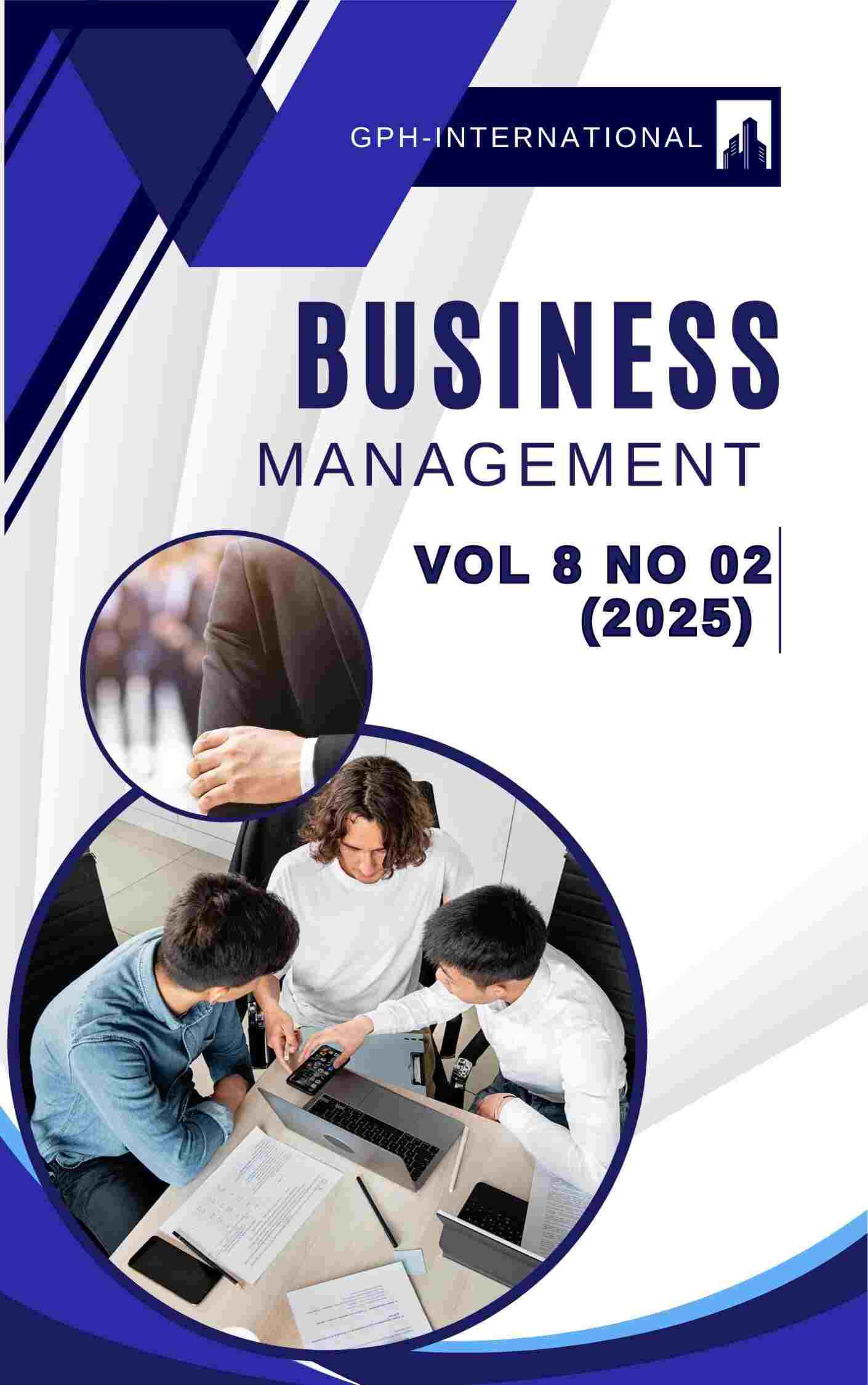Dynamics of Monetary and Fiscal Policy in the Franc CFA Zone: A Review of the Literature
Abstract
The effectiveness of monetary and fiscal policy within a monetary union has come under increasing scrutiny in recent years, particularly in the context of complex and overlapping global crises and economic shocks. This is especially true for African countries, whose economic challenges have long been associated with monetary dependency. This paper focuses on the dynamics of monetary and fiscal policies in the CFA Franc zone, which comprises two groups of West and Central African countries that share a common currency pegged to the euro and operate under a unified central bank. Specifically, it examines whether monetary policy has been effective in addressing supply and demand shocks in the markets. The paper conducts a systematic review of the literature from 1980 to 2023. Both theoretical and empirical studies are examined. Additionally, we discuss the instruments and effectiveness of monetary policy in the Franc zone, along with the challenges and prospects for its future evolution. The literature generally suggests that the Franc Zone has achieved a certain level of macroeconomic stability and convergence; however, it also faces significant constraints regarding its monetary autonomy and fiscal policy coordination. There is substantial evidence indicating that monetary policy in the Franc Zone is largely passive, and the region lacks the characteristics of an optimum currency area that would enhance its effectiveness. We propose several potential reforms to enhance the performance and resilience of the monetary union, including strengthening its institutional framework, diversifying its economic structure, and deepening its financial integration. Additionally, we recommend that future studies explore reforms aimed at making the CFA Franc an optimal currency area, as well as examining the autonomy thesis within the Franc zone.
Downloads
References
Adam, C., Alberola-Ila, E., & Tejada, A. P. (2022). Covid-19 and the monetary-fiscal policy nexus in Africa. BIS Papers.
Adedeji, O. S., & Williams, O. (2008). Fiscal reaction functions in the CFA Franc zone. Common Currency, Uncommon Challenges, 77.
Alesina, A., & Barro, R. J. (2002). Currency unions. The Quarterly Journal of Economics, 117(2), 409-436. https://doi.org/10.1162/003355302753650283
Asongu, S., Ojong, N., & Soumtang Bime, V. (2021). Central Banks' responses to the Covid-19 pandemic: The case of the Bank of Central African States. African Governance and Development Institute. WP/21/076. https://doi.org/10.2139/ssrn.3972479
Azam, J. P., & Devarajan, S. (Eds.). (1997). The CFA Franc Zone in Africa: A symposium. Journal of African Economies, 6(1), 1-2. https://doi.org/10.1093/oxfordjournals.jae.a020918
Deléchat, C., Ramirez, G., & Veyrune, R. (2008). Monetary policy in a currency union? The case of CEMAC. Common Currency, Uncommon Challenges, 27.
Banque des États de l'Afrique Centrale (2020d). Comité de politique monétaire, Décision N°04/CPM/2020, June.
Banque des États de l'Afrique Centrale (2021b). Comité de politique monétaire, Décision N°01/CPM/2021, February.
Barro, R. J., & Gordon, D. B. (1983). Rules, discretion, and reputation in a model of monetary policy. Journal of Monetary Economics, 12(1), 101-121. https://doi.org/10.1016/0304-3932(83)90051-X
Belhocine, N., Bhatia, A. V., & Frie, J. M. (2023). Raising rates with a large balance sheet: The Eurosystem's net income and its fiscal implications. https://doi.org/10.5089/9798400244643.001
Bickerton, C. (2021). 'Parliamentary,’ ‘Popular,’ and 'Pooled': Conflicts of sovereignty in the United Kingdom's exit from the European Union. In Understanding Conflicts of Sovereignty in the EU (pp. 69-84). Routledge. https://doi.org/10.4324/9781003165675-5
Biziwick, M., Cattaneo, N., & Fryer, D. (2015). The rationale for and potential role of the BRICS Contingent Reserve Arrangement. South African Journal of International Affairs, 22(3), 307-324. https://doi.org/10.1080/10220461.2015.1069208
Clarida, R., Gali, J., & Gertler, M. (2002). A simple framework for international monetary policy analysis. Journal of Monetary Economics, 49(5), 879-904. https://doi.org/10.1016/S0304-3932(02)00128-9
Combey, A. (2014). Does the WAEMU zone policy mix guarantee internal stability and growth?
Constant, F. D. (2012). The CFA franc devaluation and output growth in the Franc zone. International Journal of Financial Research, 3(1), 40. https://doi.org/10.5430/ijfr.v3n1p40
Davis, T. S. (2000). David Ricardo's macroeconomics: A study in historical perspective. (Doctoral dissertation).
Deléchat, C., Ramirez, G., & Veyrune, R. (2008). Monetary policy in a currency union? The case of CEMAC. Common Currency, Uncommon Challenges, 27.
Fischer, S. (1990). Rules versus discretion in monetary policy. Handbook of Monetary Economics, 2, 1155-1184. https://doi.org/10.1016/S1573-4498(05)80028-1
Fouopi Djiogap, C. (2012). The CFA Franc devaluation and output growth in the Franc zone. International Journal of Financial Research, 3(1), 40-48. https://doi.org/10.5430/ijfr.v3n1p40
Ghironi, F., & Rebucci, A. (2000). Monetary rules for emerging market economies. Boston College Economics Department, Working Paper No. 476.
Ghosh, A., Gulde, A.-M., Ostry, J., & Wolf, H. (1997). Does the nominal exchange rate regime matter? NBER Working Paper No. 5874. https://doi.org/10.3386/w5874
Gulde, A. M., & Tsangarides, C. G. (2008). Long-run determinants of inflation in WAEMU. In The CFA Franc Zone. International Monetary Fund.
Kenen, P. B. (1969). The international position of the dollar in a changing world. International Organization, 23(3), 705-718. https://doi.org/10.1017/S002081830001403X
Kireyev, A. (2016). Macroeconomic policy coordination. Building Integrated Economies in West Africa, 31.
Körner, H. (2002). The franc zone of West and Central Africa: A satellite system of the European Monetary Union. Intereconomics, 37, 198-203. https://doi.org/10.1007/BF02930213
Kydland, F. E., & Prescott, E. C. (1977). Rules rather than discretion: The inconsistency of optimal plans. Journal of Political Economy, 85(3), 473-491. https://doi.org/10.1086/260580
Li, Y., Sun, Y., & Chen, M. (2021). An evaluation of the impact of monetary easing policies in times of a pandemic. Frontiers in Public Health, 8, 627001. https://doi.org/10.3389/fpubh.2020.627001
McCallum, B. X. (1987). Inflation: Theory and Evidence. In B. M. Friedman & F. Hahn (Eds.), Handbook of Monetary Economics.
McKinnon, R. I. (1963). Optimum currency areas. The American Economic Review, 53(4), 717-725.
Mundell, R. A. (1961). A theory of optimum currency areas. The American Economic Review, 51(4), 657-665.
Nchadze, L. E. (2019). The Populists are Right - How the Franc CFA Impoverishes Africa. On Policy Magazine.
Nehme, G. N. (2014). Ensuring effectiveness of economic and monetary policies through considering economic schools of thought: Lebanon 1990-2010. Open Journal of Social Sciences, 2(4), 197. https://doi.org/10.4236/jss.2014.24020
Nguena, C. L., & Abimbola, T. M. (2015). Financial deepening dynamics and implication for financial policy coordination in WAEMU. Regional Integration and Policy Challenges in Africa, 201-219.
Nubukpo, K. (2012). The policy mix in the WAEMU zone: Lessons from yesterday, reflections for tomorrow. Revue Tiers Monde, 212(4), 137-152. https://doi.org/10.3917/rtm.212.0137
Nubukpo, K. K. (2017). Misalignment of exchange rates: What lessons for growth and policy mix in the WAEMU? (No. 126). GEG Working Paper.
Starr, M. (2005). Does money matter in the CIS? Effects of monetary policy on output and prices. Journal of Comparative Economics, 33(3), 441-461. https://doi.org/10.1016/j.jce.2005.05.006
Sylla, N. S. (2021). Fighting monetary colonialism in francophone Africa: Samir Amin's contribution. Review of African Political Economy, 48(167), 32-49. https://doi.org/10.1080/03056244.2021.1878123
Taylor, I. (2019). France à fric: the CFA zone in Africa and neocolonialism. Third World Quarterly, 40(6), 1064-1088. https://doi.org/10.1080/01436597.2019.1585183
Taylor, J. B. (2017). Rules versus discretion: Assessing the debate over the conduct of monetary policy. National Bureau of Economic Research. https://doi.org/10.3386/w24149
VandeWalle, N. (1991). The decline of the Franc zone: Monetary politics in Francophone Africa. African Affairs, 90(360), 383-405. https://doi.org/10.1093/oxfordjournals.afraf.a098439
Weeks, J. (2010). Why monetary policy is irrelevant in Africa South of the Sahara. Development Viewpoint No. 53, School of Oriental and African Studies, Center for Development and Policy Research, London. Available at: www.soas.ac.uk/cdpr/publications/dv/file59766.pdf (accessed October 29, 2012).
The authors and co-authors warrant that the article is their original work, does not infringe any copyright, and has not been published elsewhere. By submitting the article to GPH-International Journal of Business Management, the authors agree that the journal has the right to retract or remove the article in case of proven ethical misconduct.




























